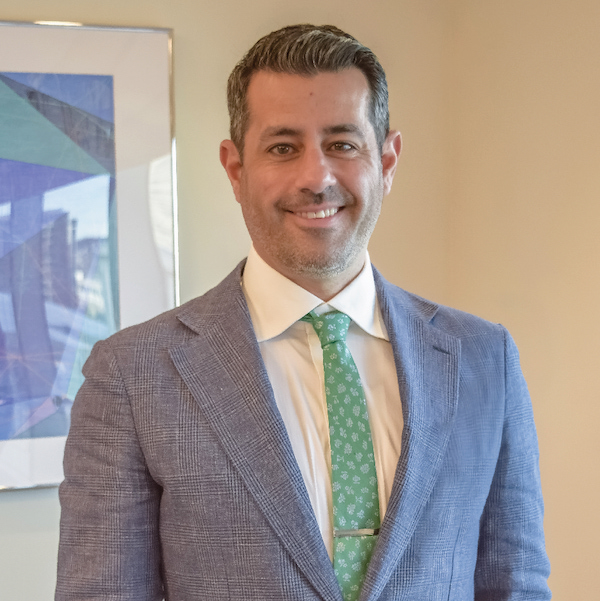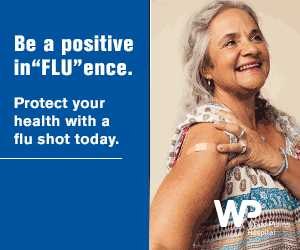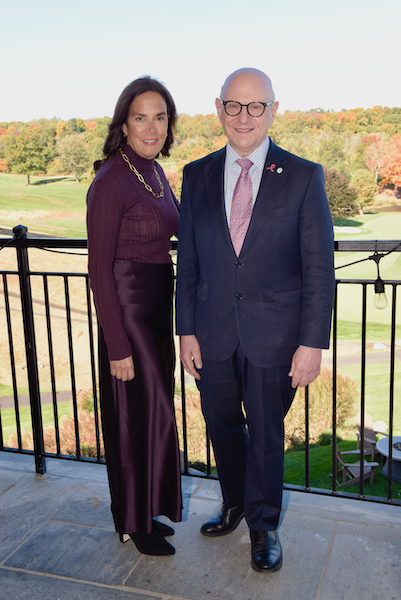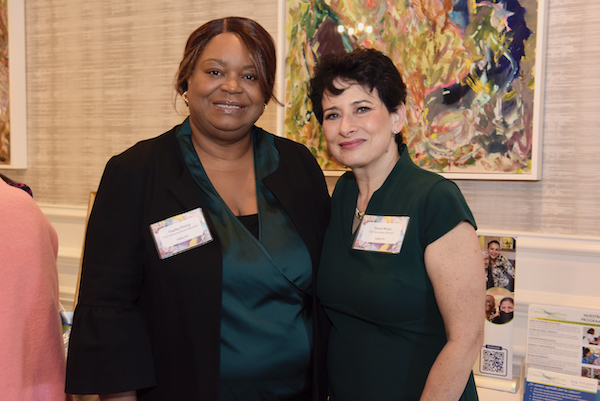Better Hearing Is Here
- Details
- Written by: Joanne Wallenstein
- Category: Health
 Submitted by Dr. Brian Nicholas, Otolaryngology, Head & Neck Surgery
Submitted by Dr. Brian Nicholas, Otolaryngology, Head & Neck Surgery
If you seem to be turning up the volume on all your devices, have a constant ringing sound in your ears, or can’t hear your friends at a noisy restaurant, it may be time to schedule a hearing test. Doing so just got easier: White Plains Hospital recently launched in-house audiology services at White Plains Hospital Medical and Wellness in Armonk, offering a variety of hearing tests and treatments.
This past summer, under the leadership of Dr. Brian Nicholas, the Director of Hearing and Balance at White Plains Hospital, the Hospital’s Otolaryngology practice debuted a dedicated sound booth equipped to test hearing in patients from infants to seniors. The large booth is also wheelchair accessible.
Having on-site services offers a major convenience for patients. “Previously, our patients had to go to an outside audiology facility, almost always on a different day, before coming to see me,” explains Dr. Nicholas. “The on-site testing booth has made a world of difference for our patients and has been a huge paradigm shift for everyone in a very positive way.”
Dr. Nicholas notes that almost every new patient he sees requires an audiogram, a test that takes about 20-30 minutes. An audiogram is a more sophisticated hearing test than what many may recall from grade school days. It objectively measures a patient’s degree of hearing loss by quantifying and qualifying the results. Dr. Nicholas and his team not only see patients whose primary complaint is hearing loss but also patients who experience dizziness or tinnitus (ringing in the ear), a condition that affects approximately 50 million Americans.
Dr. Nicholas suggests that most patients should begin hearing testing when they turn 50. Based on those baseline findings, additional testing can occur annually or, every two to five years. In certain occupations with high noise exposure, such as musicians, soldiers, or construction workers, earlier testing may be warranted. His practice is also seeing a larger number of younger patients which may be in part due to the prevalence of headphones and earbuds.
The Hearing-Cognition Link
In the medical community, there has been a lot of discussion recently about the link between cognitive decline and hearing loss. “While we do not know if the link is causal or not, we do know definitely that rehabbing an individual’s hearing protects against cognitive decline,” says Dr. Nicholas.
Patients with hearing loss have a range of available treatment options, depending on the cause and severity of the loss. Medications such as oral steroids or nasal sprays may help. If a patient experiences sudden hearing loss, however, they should be seen as quickly as possible for the best outcomes. “We will always squeeze in a patient for a same-day appointment for an otologic emergency,” Dr. Nicholas notes.
For severe and irreversible hearing loss, patients may benefit from hearing aids or cochlear implants. The good news is that patients can now discuss all these options with Dr. Nicholas and his team, often on the same day as their audiogram, in a streamlined process that allows them to quickly begin their journey to better hearing.
To schedule an audiology test with Dr. Nicholas and team at White Plains Hospital Medical & Wellness, located at 99 Business Park Drive in Armonk, call 914-849-3755.
Do You Need a Hearing Test?
Take the NIH assessment to help you determine if you need to have your hearing tested by a health professional.
Dr. Brian D. Nicholas is the Director of Hearing and Balance at White Plains Hospital, and sees patients at 122 Maple Ave. in White Plains and at 21 Laurel Ave., Suite 290, in Cornwall. To make an appointment, call 914-849-3755.
Health Matters
The original version of this article was published in Health Matters, a White Plains Hospital publication.
Is Soup Really Good Food?
- Details
- Written by: Joanne Wallenstein
- Category: Health
 (Submitted by Elizabeth DeRobertis, Registered Dietitian)
(Submitted by Elizabeth DeRobertis, Registered Dietitian)
“Soup is good food” was Campbell’s motto for much of the 1970s and ‘80s. (Not only has that ad campaign long ended, the company recently announced plans to drop “soup” from its name after 155 years.) But does soup actually have health benefits? Following are some straight answers to some frequently asked soupy questions.
1. Does soup really have healing properties?
Yes, chicken soup in particular does have some scientifically supported benefits, especially when you’re sick. According to research, chicken soup has been shown to slow the movement of neutrophils (a type of white blood cell), potentially reducing inflammation and alleviating symptoms of upper respiratory infections such as congestion.
2. Do cooked vegetables in soup retain their nutritional value?
While cooking can reduce certain vitamins like Vitamin C, many nutrients such as fiber and minerals (potassium, calcium, magnesium) remain intact. Some nutrients, like lycopene (found in tomatoes) and beta-carotene (found in carrots) become more readily absorbed after cooking.
3. Quinoa is frequently used as a substitute for barley in soups. Which is better for you?
Quinoa is higher in protein and contains all nine essential amino acids, making it a complete protein. Quinoa also has a lower glycemic index compared to barley, which can be a better choice for those managing blood sugar levels. On the other hand, barley is higher in dietary fiber, which is beneficial for digestive health
4. Besides starting with a low-sodium broth, what else can you do to make homemade soup healthier?
To reduce fat and calorie content in soups, you can swap out cream for unsweetened almond milk, coconut milk, or Greek yogurt. Studies show that these alternatives offer similar textures while significantly lowering fat content.
Additional suggestions:
• Add legumes like beans or lentils to boost protein and fiber, making the soup more filling and nutritious
• Use lean proteins by opting for skinless chicken, turkey, or tofu instead of higher-fat meats like sausage or fatty cuts of beef
• Increase vegetable content to boost nutrient density by adding more veggies like spinach, kale, zucchini, and carrots
• Use spices and herbs for flavor and to reduce reliance on salt by using fresh herbs (parsley, cilantro) and spices (turmeric, cumin, chili flakes) to enhance the flavor profile
• Go with whole grains or brown rice in place of refined grains
• You can follow the above recommendations as well when it comes to heartier fare like chili and stew.
5. What kinds of soups do you like/recommend?
I tend to enjoy soups that are nourishing and packed with flavor. One of my favorites is lentil soup because it’s hearty, rich in plant-based protein, and loaded with fiber. The combination of lentils, vegetables, and spices makes it comforting while still being light and healthy. It’s also versatile; you can add whatever vegetables you have on hand, and it’s easy to customize the spice level.
Another favorite is butternut squash soup for its creamy (non-dairy) texture, high Vitamin A content, and mildly sweet flavor.
Each of these suggestions is backed by research showing how small changes to soup ingredients can boost its overall health benefits.
For other ideas, I recommend the following sites:
https://www.eatingwell.com/gallery/8024847/winter-soups-to-make-forever/
https://www.delish.com/cooking/nutrition/g660/healthy-soups-myplate/
https://www.prevention.com/food-nutrition/healthy-eating/g22566576/slow-cooker-soup-recipes/ If you are still in doubt, contact a professional dietitian.
If you are still in doubt, contact a professional dietitian.
Elizabeth DeRobertis is a Registered Dietitian with the Scarsdale Medical Group. To make an appointment, call 914-723-8100.
Health Matters
The original version of this article was published in Health Matters, a White Plains Hospital publication.
How Stress Can Affect Your Heart
- Details
- Written by: Joanne Wallenstein
- Category: Health
 The following was submitted by Dr. Jeannette L. Yuen, Cardiologist at White Plains Hospital
The following was submitted by Dr. Jeannette L. Yuen, Cardiologist at White Plains Hospital
Current events, job stress, daily obligations, and relationship tensions can all severely and negatively impact good cardiac health.
“Studies have linked events such as bereavement, loss of a job, and depression with major, life-threatening events such as a heart attack and sudden cardiac arrest,” notes Dr. Jeannette Yuen, a cardiologist with Scarsdale Medical Group/White Plains Hospital. “But daily stress can also aggravate underlying conditions that can affect short-term and long-term health.”
If you have been experiencing significant stress, common symptoms to look for include chest pain, dizziness, sweating, hypertension, and shortness of breath, which may be contributing to the following conditions:
Extreme stress can lead to a condition called takotsubo cardiomyopathy, also known as “broken heart syndrome,” which is more commonly seen in women. During an emotionally stressful event, the heart is overwhelmed by a rush of adrenaline and inflammatory hormones. This weakens the heart, rendering it unable to pump blood efficiently, while other parts of the organ continue to work just as hard or harder. Additionally, there is a small risk of persistent heart muscle failure – presenting as shortness of breath or diminished physical ability. “Luckily, this condition is treatable and mostly reversible,” says Dr. Yuen. “Finding strategies to help cope with ongoing stressful and acutely traumatic events will help lessen the source of stress on the heart.”
Stress-Induced Angina
When the heart muscle doesn’t get enough oxygen, the result is chest pain or “angina” – your heart’s way of telling you it needs more blood flow to function properly. When you become angry or stressed, your blood pressure goes up and toxic hormone surges can lead to spasms in the arteries. Left untreated, angina and the constant deprivation of oxygen and blood flow to the heart could result in spasms, a heart attack or heart failure in some cases.
Arteriosclerosis
Additionally, chronic stress and depression can also worsen arteriosclerosis, a condition that occurs when plaque builds up in arteries, therefore causing spasms and clogging your arteries. Depression can also lead to less motivation to exercise and eating more comfort foods, worsening cholesterol levels and contributing even more to the condition.
Find ways to cope:
If chronic stress has seeped into your life, talk to your primary care physician or cardiologist about diagnosing and treating a possible heart condition. Incorporating some of these calming strategies into your day can take a load off your heart, as well, says Dr. Yuen:
• Relaxing through gentle exercises and possibly through a more vigorous exercise program under the supervision of your clinician
• Finding a quiet environment to relax and recharge during stressful times of the day
• In some cases, counseling or therapy can help you identify your stressors and develop techniques to overcome them or respond to them less anxiously and more proactively
If you are experiencing sudden symptoms such as chest pain or pressure; pain in the back, arm or jaw; shortness of breath; or a cold sweat, nausea or lightheadedness, it’s important to call 9-1-1 right away so you can be evaluated and treated.
Dr. Jeannette Yuen is a Cardiologist with Scarsdale Medical Group, seeing patients at the Harrison location. To make an appointment, please call 914-723-8100.
Health Matters
The original version of this article was published in Health Matters, a White Plains Hospital publication.
Fair or Fowl? Trying Chicken for Breakfast
- Details
- Written by: Joanne Wallenstein
- Category: Health
 Submitted by Elizabeth DeRobertis, Registered Dietitian at White Plains Hospital
Submitted by Elizabeth DeRobertis, Registered Dietitian at White Plains Hospital
When patients ask me the best food for them to eat in the morning, I think they're often surprised when I say “chicken.” To be honest, I haven't really had the nerve to say it to that many people, but it has been on my mind a lot.
Certain items are categorized as “breakfast foods,” while we would never dream of eating some others in the morning. But as a registered dietitian, I can tell you that starting your day with a high protein breakfast is very helpful for weight management – as opposed to such traditional breakfast foods as bagels, cold and hot cereal, waffles, pancakes, pastries and the like, all of which are very high in carbohydrates.
When we start the day with a high carbohydrate breakfast, our body needs to produce more insulin to keep our blood sugar down. When we have extra insulin circulating in our body, it actually makes us feel hungrier and crave more carbohydrates. If we start the day with a high protein breakfast, most people tend to feel more satiated and have an easier time staying on track during the day.
The only problem with this is that there are not that many proteins that we consider breakfast foods. I often recommend that my patients eat eggs for breakfast in whatever style they prefer, as they do not raise cholesterol. For variety, I often recommend other high protein options such as Greek yogurt or cottage cheese in the morning.
Why do we eat smoked salmon in the morning, but not other types of fish? And why do we eat eggs, but not chicken?
The answer, I suppose, is that “people don’t do that,” but I think we should start a trend of eating chicken for breakfast. There have been days where I have eaten a piece of chicken or rolled up a few pieces of turkey, and I am measurably better satiated throughout the day. (Of course, there are also days when I eat something with carbohydrates, whether it's popping a few pieces of fruit into my mouth that I'm cutting up for my daughter or – dare I admit – one of her Munchkins. By mid-morning, my stomach is literally growling.)
I challenge you to try this experiment yourself. Switch your breakfast over to something that's very high in protein, even if it's not a traditional breakfast food, and see how you feel during the day. My patients often start off worried about not having toast with their eggs, or that not having a carbohydrate breakfast will leave them too hungry. But each time the feedback that I receive is that they actually feel better and are less hungry during the day.
So why not try chicken for breakfast? Here are some high-protein, low-carb breakfast recipes, along with their calorie counts:
1. Chicken and Spinach Egg Muffins
Ingredients and Calorie Count:
• 1 cup cooked chicken breast, diced (approx. 130 calories)
• 6 large eggs (approx. 420 calories)
• 1 cup fresh spinach, chopped (approx. 7 calories)
• 1/4 cup shredded cheese, optional (approx. 110 calories)
• Total calories: approx. 667 calories (about 111 calories per muffin if divided into 6 muffins)
• Without cheese: approx. 557 calories total (about 93 calories per muffin)
2. Turkey and Avocado Breakfast Salad
Ingredients and Calorie Count:
• 4 oz. cooked turkey breast, diced (approx. 140 calories)
• 1/2 avocado, diced (approx. 120 calories)
• 1 cup mixed greens (approx. 5 calories)
• 1 tbsp olive oil (approx. 120 calories)
• Total calories: approx. 385 calories
3. Salmon and Cucumber Roll-Ups
Ingredients and Calorie Count:
• 4 oz. smoked or grilled salmon (approx. 160 calories)
• 1/2 cucumber, thinly sliced (approx. 8 calories)
• 2 tbsp. cream cheese or Greek yogurt (approx. 70 calories)
• Total calories: approx. 238 calories
4. Turkey Sausage and Pepper Stir-Fry
Ingredients and Calorie Count:
• 1 turkey sausage link (approx. 100 calories, varies by brand)
• 1/2 bell pepper, diced (approx. 12 calories)
• 1/2 small onion, diced (approx. 20 calories)
• 1 cup spinach (approx. 7 calories)
• Total calories: approx. 139 calories
5. Tuna and Egg Salad Lettuce Wraps
Ingredients and Calorie Count:
• 1 can of tuna, drained (approx. 120 calories)
• 2 hard-boiled eggs (approx. 140 calories)
• 1 tbsp. light mayonnaise or Greek yogurt (approx. 35 calories)
• Lettuce leaves (approx. 5 calories)
• Total calories: approx. 300 calories
These calorie counts can help you plan your meals to fit your dietary goals, keeping them high in protein and low in carbs. Good luck!
Elizabeth DeRobertis is a Registered Dietitian with the Scarsdale Medical Group. To make an appointment, call 914-723-8100.
Health Matters
The original version of this article was published in Health Matters, a White Plains Hospital publication.
Hope Is on the Way for Cancer Patients
- Details
- Written by: Bill Doescher
- Category: Health
 Chair Annmarie Formato and Dr. Larry Norton of Memorial Sloan KetteringThe packed house of guests at the Scarsdale Golf Club (SGC) who attended the Cancer Support Team (CST) ‘s 25th Annual Gayle K. Lee Health Education Luncheon on Thursday, October 17 came away with a most positive message: “Hope is definitely on the way for the cancer patients of today and tomorrow.”
Chair Annmarie Formato and Dr. Larry Norton of Memorial Sloan KetteringThe packed house of guests at the Scarsdale Golf Club (SGC) who attended the Cancer Support Team (CST) ‘s 25th Annual Gayle K. Lee Health Education Luncheon on Thursday, October 17 came away with a most positive message: “Hope is definitely on the way for the cancer patients of today and tomorrow.”
Why? Because Larry Norton, MD, the featured luncheon speaker and one of the country’s most highly recognized and respected oncologists, told them so.
Norton had a supporting cast to back him up, including Luncheon Committee Chair Annmarie Formato, former registered CST nurse Geraldine Durkin who received a special recognition at the luncheon, and current CST nurse Caridad Aponte, who provided an opening prayer with a wonderful message of hope.
In introducing Norton to the gathering, Formato praised him for his personal work on her on a breast cancer case for 25 years.
“You’ll be fine, you will be fine.”
Among other things, Formato said, “It was 25 years ago, at the age of 32, when I was diagnosed with breast cancer. I had just given birth to my daughter Avery, and my son Austin was only 2-1/2 years old. At that time in my life, breast cancer was a foreign language. I didn’t know anyone who had breast cancer. . .I had my surgery at Memorial Sloan Kettering (MSK), and I remember my surgeon telling me, ‘I don’t know who I’ll have to call to make this happen, but you must have Larry Norton as your oncologist’ . . . When I met Dr. Norton, he said, you’ll be fine, you will be fine.”
The emotional doctor-patient hug at the podium said it all.  CST Staff
CST Staff
In his remarks, the renowned oncologist, MSK’s Norna S. Sarofin Chair of Clinical Oncology as well as MSK Senior Vice President in the Office of the President and Medical Director of the Evelyn H. Lauder Breast Cancer Center there, cited important new cancer research his own organization and others were conducting. Surprisingly, he also noted that Artificial Intelligence was a powerful tool in advancing cancer research and is being used to help analyze the large amounts of data that have been gathered in search of cures and how to properly go about using them. “AI can indeed analyze all kinds of data,” he said.
In addition, without a prepared speech, Norton enthusiastically explained the advances in cancer treatment. In medical terms, he talked about the value of research into personalized cancer vaccines. In addition, Norton advocated for active patient/doctor partnerships in care. In particular, Norton discussed the important need for patients to carefully analyze all treatment possibilities, be prepared to ask their doctors good questions, and then listen very carefully.
“Take advantage of the many advances.”
 Gayley Henry and Tania Weiss
Gayley Henry and Tania Weiss
“The big question for you,” Norton said, “is how to take advantage of the many advances.” In providing plenty of doctor-to-patient advice, Norton emphasized that it’s extremely important for cancer patients to find the right doctor. And he said, which drew a chuckle from those in the audience, “If you think that you don’t like the doctor you selected, chances are he doesn’t like you either.”
Obviously, a favorite speaker for the CST folks, this wasn’t Norton’s first visit to CST’s annual luncheons. He was the speaker at CST’s fourth annual luncheon in 2002 and for the eleventh event in 2009. Somewhere down the road, you should fully expect he’ll be invited again if his schedule permits. He certainly does draw a crowd, and his expert advice is always on the money.  CST Patients
CST Patients
As staff was clearing the tables and smiling guests were exchanging goodbyes and leaving SGC, CST Executive Director Tania Weiss said, “It truly was a remarkable event. The luncheon is a fundraiser, and it certainly exceeded our goal. On behalf of our patients, we thank everyone who came and supported us to make this luncheon a huge success.”
The luncheon was a win-win for CST, because it increased awareness and raised necessary funds to support its main goal of helping cancer patients in Westchester County by providing professional and compassionate nursing education, rides to treatment, limited financial assistance and other supportive services – all free of charge.
Editor’s Note: Bill Doescher is a member of CST’s Advisory Board.










